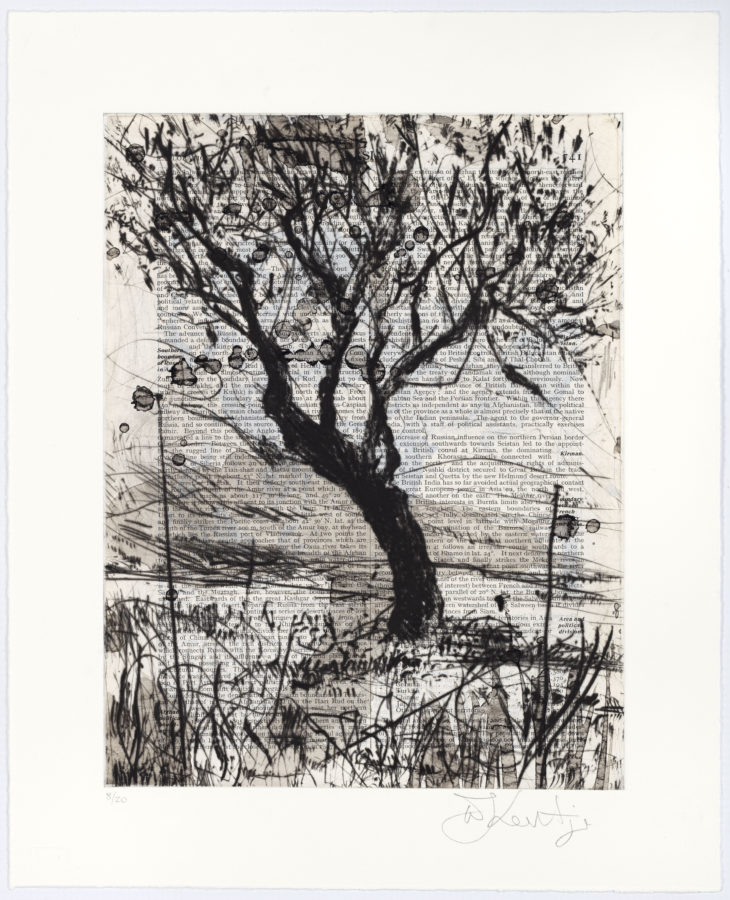Tree (Britannica)
AVAILABLE IN NYC
Trees have played an important role in the development of Kentridge’s artistic lexicon and have been present in his work in a variety of forms, the power of the trope ringing out in different ways through a number of Kentridge’s bodies of work.
Kentridge has spoken frequently about the influence that images and ideas of trees have had in his life, and the ways in which these have become integrated into his work. In a lecture given at Berlin Mosse in 2014, Kentridge talks of the “tree as lehrstück” or the “lesson play” associated with Bertolt Brecht’s epic genre of theatre that explored acting as a route to learning; of the reluctance of a Swedish boat builder who worked on Kentridge’s Black Box project to use German oak, because of the shrapnel contained in the wood, and of the strange sense of “trees still living holding the history in them.” In the same lecture, Kentridge ruminates on our ability to “meet the tree halfway” in our construction of meaning around it, and on the porousness of knowledge.
In another lecture, delivered as part of his Humanitas Visiting Professorship in Contemporary Art at Oxford University in May 2013, Kentridge remembers mishearing a word – tree-search, instead of t-shirt – and suddenly “in half a second, a whole etymology and history and examples of tree-searches unfolded.” In another instance of mis-heard words, Kentridge’s memory of his father working on the Treason Trial, or the “trees and tile” to his boyhood ears, has yielded innumerable metaphors for understanding the relationship between what we know and how we experience the world, piecing together fragments and fitting them together as we wend our way through the complex forest of history. In a conversation with Jane Taylor, Kentridge also recalls his frustration as a child that two white stinkwood trees at his family home in Houghton seemed to refuse to grow big enough to suspend a hammock between them, and his grief at the death of one of these trees during a lightning storm, many years later when he returned to occupy the same home in which he grew up. Over the course of decades, Kentridge has drawn out the metaphorical richness that trees offer to sense-making within his multidisciplinary practice: “a tree you could disassemble into its pages and hide in a library, like hiding a book in a forest.” The fact that Kentridge’s hometown and the locus of much of his work is Johannesburg, often called the largest human-made forest, cannot be overlooked.
In Tree (Century Dictionary) and Tree (Britannica), Kentridge returns to another method of interrogating meaning, and meaning-making, that is perennial in his practice. In both of these works, the images of trees appear on pages from dictionaries and encyclopaedias which have been hand-painted by Kentridge. Both of these pages are considered tomes of absolute knowledge. However, in both cases, the recording and dissemination of knowledge is subject to constant change, calling into question the concept of a categorical understanding of the world and its history. Visually resonant with his larger drawings of trees, an entire room of which was presented at his current retrospective at the Royal Academy, Tree (Century Dictionary) and Tree (Britannica) speak to Kentridge’s sense, as described in a conversation with Jane Taylor, of “making the tree page by page, growing it from the trunk up, filling the branches with paper leaves and with the marks of the bad brush, the ink in the bark: a tree you could disassemble into its pages and hide in a library, like hiding a book in a forest.”
Text by Jacqueline Flint, 2022
| Artist: | William Kentridge |
| Title: | Tree (Britannica) |
| More about: | William Kentridge |
| Year: | 2022 |
| Artwork Category:: | Editions and multiples published by David Krut and Jillian Ross Print |
| Media & Techniques: | Drypoint on handpainted Britannica dictionary paper |
| Printer: | Jillian Ross and Roxy Kaczmarek |
| Edition Size: | 20 |
| Image Height: | 29.2 cm |
| Image Width: | 20 cm |
| Sheet Height: | 37.5 cm |
| Sheet Width: | 30 cm |
| Availability: | Available |
| Framing: | Unframed |
